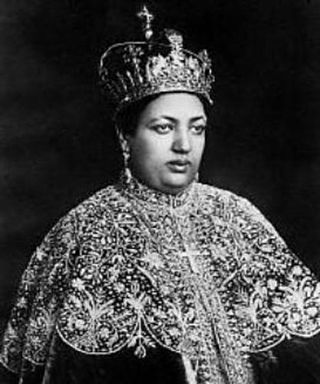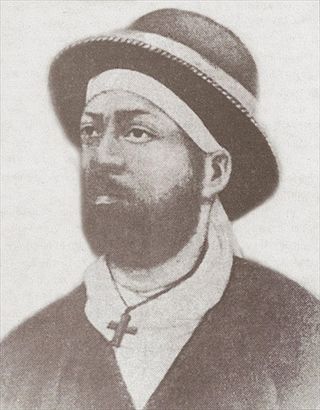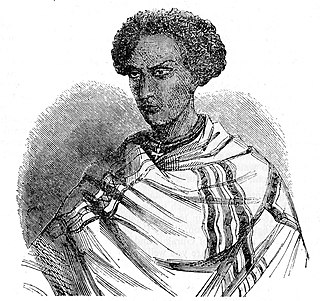Notes
- ↑ Donald Crummey, Priests and Politicians, 1972 (Hollywood: Tsehai, 2007), pp. 50f
Woizero Zenebework was the wife of Wossen Seged, Merid Azmach of Shewa; the mother of Negus Sahle Selassie, the first Negus of Shewa; the grandmother of Negus Haile Melekot of Shewa; and the great-grandmother of Emperor Menelik II. Woizero Zenebework held the powerful districts of Menz and Tegulet as her personal fiefs.
Zenebework was the most powerful woman in Shewa during the reigns of her husband, son and grandson. Despite the efforts of Sahle Selassie to resolve the ongoing theological disputes that affected the Ethiopian Church in Shewa, she intervened on behalf of the Sost Lidat, which led to an edict on 24 November 1841 which purged all of the clergy who did not embrace that view on the nature of Christ. [1] She joined her daughter-in-law Bezabish in betraying her grandson Haile Melekot by submitting to Emperor Tewodros II of Ethiopia when he invaded Shewa in 1855 to forcefully re-incorporate it into the Empire.

Menelik II, baptised as Sahle Maryam was King of Shewa from 1866 to 1889 and Emperor of Ethiopia from 1889 to his death in 1913. At the height of his internal power and external prestige, the process of territorial expansion and creation of the modern empire-state was completed by 1898.

RasMakonnen Wolde Mikael Wolde Melekot, or simply Ras Makonnen, also known as Abba Qagnew, was an Ethiopian royal from Shewa, a military leader, the governor of Harar, and the father of future Emperor Haile Selassie. Described by Nikolai Gumilev as “one of the greatest leaders of Abyssinia”, he served in the First Italo-Ethiopian War, playing a key role at the Battle of Adwa. Ras Makonnen was commonly referred to as “the Napoleon of Africa”.

Zewditu was Empress of Ethiopia from 1916 to 1930. The first female head of an internationally recognized country in Africa in the 19th and 20th centuries, and the first and only empress regnant of the Ethiopian Empire, her reign was noted for the reforms of her Regent and designated heir Ras Tafari Makonnen, about which she was at best ambivalent and often stridently opposed, due to her staunch conservatism and strong religious devotion. She is the most recent empress regnant, as well as the last female Ethiopian head of state until the 2018 election of Sahle-Work Zewde as president.

Menen Asfaw was Empress of Ethiopia as the wife of Emperor Haile Selassie.

The Solomonic dynasty, also known as the House of Solomon, was the ruling dynasty of the Ethiopian Empire from the thirteenth to twentieth centuries. The dynasty was founded by Yekuno Amlak, who overthrew the Zagwe dynasty in 1270. His successors claimed he was descended from the legendary king Menelik I, the supposed son of the biblical King Solomon and the Queen of Sheba, in order to legitimize the dynasty's assumption of power. Although this claimed ancestry gave the dynasty its name, there is no credible evidence that the dynasty was descended from Solomon or the Davidic line. The Solomonic dynasty remained in power until 1974, when its last emperor Haile Selassie was overthrown by a coup d'état.

Haile Malakot was Negus of Shewa, a historical region of Ethiopia, from 12 October 1847 until his death. He was the oldest son of Negus Sahle Selassie an important Amhara noblemen and his wife Woizero Bezabish Wolde.
Princess Zenebework, also called Zeneba Worq, was the second daughter of Emperor Haile Selassie of Ethiopia, and his wife the Empress Menen Asfaw. Zenebework's full title was "Her Imperial Highness, Princess Zenebework Haile Selassie".

Ermias Sahle Selassie is the only son of Prince Sahle Selassie of Ethiopia and Princess Mahisente Habte Mariam. He is the grandson of Emperor Haile Selassie of Ethiopia, and furthermore of Dejazmach Habte Mariam Gebre-Igziabiher, also known as Kumsa Moroda who was the third and last Moti, or ruler, of the Welega kingdom also referred as the Leqa Neqamte state. Moroda Bekere. Currently the prince is ninth in the line of succession to the vacant imperial throne.

Until the end of the Ethiopian monarchy in 1974, there were two categories of nobility in Ethiopia and Eritrea. The Mesafint, the hereditary nobility, formed the upper echelon of the ruling class. The Mekwanint were the appointed nobles, often of humble birth, who formed the bulk of the aristocracy. Until the 20th century, the most powerful people at court were generally members of the Mekwanint appointed by the monarch, while regionally, the Mesafint enjoyed greater influence and power. Emperor Haile Selassie greatly curtailed the power of the Mesafint to the benefit of the Mekwanint, who by then were essentially coterminous with the Ethiopian government.

Sahle Selassie was a ruler and later King of Shewa from 1813 to 1847. An important Amhara noble of Ethiopia, he was a younger son of Wossen Seged. Sahle Selassie was the father of numerous sons, among them Haile Melekot, Haile Mikael, Seyfe Sahle Selassie, Amarkegne and Darge Sahle Selassie; his daughters included Tenagnework, Ayahilush, Wossenyelesh, Birkinesh, and Tinfelesh.
Woizero Bezabish Wolde was the wife of Sahle Selassie, Negus of Shewa, mother of King Haile Melekot of Shewa, and grandmother of Emperor Menelik II. She held the districts of Bulga and Yifat as her personal fiefs. Bezabish would become infamous for betraying her son Haile Melekot by submitting to his opponent Emperor Tewodros II during the latter's forcible re-incorporation of Shewa under the direct rule of the Imperial throne in 1855.

Princess Mahisente Habte Mariam(born at Nekemte on 9 February 1937) is the widow of Prince Sahle Selassie, youngest son of Emperor Haile Selassie of Ethiopia. She is the daughter of Dejazmach Habte Mariam Gebre-Igziabiher, also referred as Kumsa Moroda heir to the former Welega Kingdom of Leqa Naqamte, and later served as governor of Welega province. Her mother was Woizero Yeshimebet Guma, grand daughterof Moti Joté Tulu of Wesstern Welega]] [Oromo people|Oromo]] noblewoman who was later married to Ras Mesfin Selashi, a leading Ethiopian aristocrat and close associate of Emperor Haile Selassie. Princess Mahisente is also the mother of Prince Ermias Sahle Selassie, the current President of the Crown Council of Ethiopia.
Wolete Israel Seyoum was the daughter of Leul Ras Seyoum Mengesha, Prince of Tigray, KBE, and great-granddaughter of Emperor Yohannes IV of Ethiopia.

Darge Sahle Selassie Horse name Abba Gersa was a 19th-century Ethiopian nobleman, provincial governor, general and a trusted councillor of his nephew Emperor Menelik II.
Tesseme Darge was the daughter of Ras Darge Sahle Selassie, prince of Selale, and granddaughter of Sahle Selassie, king of Shewa in the Ethiopian Empire. She was a first cousin to Emperor Menelik II.
Tsehaiwork Darge was the daughter of Ras Darge Sahle Selassie, Prince of Selale, and granddaughter of Sahle Selassie, King of Shewa from 1813 to 1847.

Seyoum Mengesha KBE was an army commander and a member of the royal family of the Ethiopian Empire.

NegusMikael of Wollo, was an army commander and a member of the nobility of the Ethiopian Empire. He was the father of the "uncrowned" Emperor Lij Iyasu, and the grandfather of Empress Menen, wife of Emperor Haile Selassie. He changed his name to Mikael upon converting to Christianity.
Bafena Wolde Mikael or beter known as just Bafena (1834-1887) was the second wife of Menelik II then the King of Shewa. She was described as ‘‘attractive, vivacious and ambitious’’ and is remembered for her failed conspiracy against her husband, in a attempted coup plot in 1877.
Garmame and Horse name: Abba Mala was an influential 19th century Ethiopian military commander, provincial governor and royal counsellor serving under Negus Sahle Selassie, Haile Melekot and Emperor Menelik II. He held the title of Dejazmach. Garmame is remembered for his leading role in rescuing Menelik II and other notables from captivity in July 1865, and restoring the Shewan heir back to the throne. In May 1877 he prevented a coup concocted by Bafena, and solidified the position of his Negus. After retirement from military activities, Garmame governed large tracts of fertile land south of Ankober, and is also remembered for his role in providing relief to the people during the disastrous 1890's famine'.